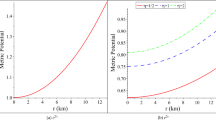Abstract
According to the general results of a previous work (Caimmi, 1980; hereafter referred to as Paper I), solutions to EC equation, which expresses a necessary and sufficient condition for equilibrium of Emden-Chandresekhar axisymmetric, solid-body rotating polytropes (EC polytropes), are taken into consideration, of the type
with ϑ 2l later defined as the EC associated function of degree 2l. Thus the EC equation, involving (ϑ, μ), is found to be equivalent to the infinite set of EC associated equations, involving ϑ 2l (μ). We approximate g (ϑ, μ) by neglecting all terms of degree higher than 2 which appear in the above expression, and then search power series solutions to EC associated equations of degree 0 and 2, corresponding to any choice ofn (polytropic index, related to density distribution) andv (related to rotational distorsion). To this aim, we extend the methods used by Seidov and Kuzakhmedov (1977), and Mohan and Al-Bayaty (1980), to construct power series of the type outlined above, related to solid-body rotating configurations and originating both inside and outside the radial boundary (defined as the first zero of ϑ0(μ)=0). The corresponding expressions of ϑ0 and ϑ2 may serve to derive an approximate expression of, and future work becomes possible concerning the determination of some physical parameters (such as volume, mass, potential energy, angular momentum) related to any choice ofn andv.
Computations have been performed forn=k/4 (0≤k≤20, i.e. 0≤n≤5) andv=0,v≈v R/2,v≈v R, withv R lowest value ofv leading to balance between gravitation and centrifugal force at the equator of the system. An upper limit to the error, ε*(μ), done in computing ϑ 2l , ϑ‚ 2l , and ϑ„ 2l at any point ϑ for a given choice ofn andv, is estimated, ranging from large values (ε*=1E-2) forn close enough to 0 and ϑ close enough or outside the radial boundary, to low values (ε*=1E-10) forn far enough from 0 and no constraint on ϑ. Comparison between results of this paper and the accurate results by Linnell (1977, 1981) obtained using a different approach and available forn=2,v=0, andn=3,v=0, lead to a fair agreement (up to (1E−5−1E−6).
It is apparent that the method followed here continues to hold when the first EC associated functions up to degree 2l are taken into account, leading — at least in way of principle — to a more refined approximation to the EC function; this would only make the related calculations much more complicated.
Similar content being viewed by others
References
Caimmi, R.: 1980,Astrophys. Space Sci. 71, 415 (Paper I).
Chandrasekhar, S.: 1933,Monthly Notices Roy. Astron. Soc. 93, 390.
Chandrasekhar, S.: 1939,An Introduction to the Study of Stellar Structure, The University of Chicago Press, Chapter IV.
Chandrasekhar, S. and Lebovitz, N. R.: 1962,Astrophys. J. 136, 1082.
Goldreich, P., and Weber, S. V.: 1980,Astrophys. J. 238, 991.
Gradsteyn, I. S. and Ryzhik, I. M.: 1965,Tables of Integrals, Series and Products, Academic Press Inc., New York.
Ledoux, P.: 1974, in P. Ledoux, A. Noels, and A. W. Rodgers (eds.), ‘Stellar Instability and Evolution’,IAU Symp. 59, 135.
Linnell, A. P.: 1977,Astrophys. Space Sci. 48, 165.
Linnell, A. P.: 1981,Astrophys. Space Sci. 76, 61.
MacMillan, W. D.: 1930,The Theory of the Potential, Dover Publications, Chapter VII.
Mohan, C. and Al-Bayaty, A. R.: 1980,Astrophys. Space Sci. 73, 227 (Ref. II).
Sadler, D. H. and Miller, J. C. P.: 1932,British Association for the Advancement of Science, Mathematical Tables, Vol. 2, Office of the British Association, London.
Seidov, Z. F. and Kuzakhmedov, R. Kh.: 1977,Soviet Astron. 21(3), 399 (Ref. I).
Vandervoort, P. O.: 1980,Astrophys. J. 241, 316.
Vandervoort, P. O. and Welty, D. E.: 1981,Astrophys. J. 248, 504.
Zeldovich, Ya. B. and Novikov, I. D.: 1971,Gravitation Theory and Stellar Evolution, (in Russian), Nauka, Moscow.
Author information
Authors and Affiliations
Rights and permissions
About this article
Cite this article
Caimmi, R. Emden-chandrasekhar axisymmetric, solid-body rotating polytropes. Astrophys Space Sci 89, 255–277 (1983). https://doi.org/10.1007/BF00655979
Received:
Issue Date:
DOI: https://doi.org/10.1007/BF00655979




